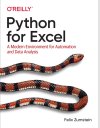Python for Excel: A Modern Environment for Automation and Data Analysis
Автор: Felix Zumstein (2021)

Microsoft is running a feedback forum for Excel on UserVoice where everybody can submit a new idea for others to vote on. The top voted feature request is “Python as an Excel scripting language,” and it has roughly twice as many votes as the second most voted feature request. Though nothing really happened since the idea was added in 2015, Excel users were fueled with new hope at the end of 2020 when Guido van Rossum, the creator of Python, tweeted that his “retirement was boring” and he would join Microsoft. If his move has any influence on the integration of Excel and Python, I don’t know. I do know, however, what makes this combination so compelling and how you can start using Excel and Python together—today. And this is, in a nutshell, what this book is about. The main driving force behind the Python for Excel story is the fact that we are living in a world of data. Nowadays, huge datasets are available to everybody and about everything. Often, these datasets are so big that they don’t fit into a spreadsheet anymore. A few years ago, this may have been referred to as big data, but nowadays, a dataset of a few million rows is really nothing special. Excel has evolved to cope with that trend: it introduced Power Query to load and clean datasets that don’t fit into a spreadsheet and Power Pivot, an add-in to perform data analysis on these datasets and present the results. Power Query is based on the Power Query M formula language (M), while Power Pivot defines formulas by using Data Analysis Expressions (DAX). If you also want to automate a few things in your Excel file, then you would use Excel’s built-in automation language, Visual Basic for Applications (VBA). That is, for something fairly simple, you can end up using VBA, M, and DAX. One issue with this is that all these languages only serve you in the Microsoft world, most prominently in Excel and Power BI (I will introduce Power BI briefly in Chapter 1). Python, on the other hand, is a general-purpose programming language that has become one of the most popular choices amongst analysts and data scientists. If you use Python with Excel, you are able to use a programming language that is good at all aspects of the story, whether that’s automating Excel, accessing and preparing datasets, or performing data analysis and visualization tasks. Most importantly, you can reuse your Python skills outside of Excel: if you need to scale up your computing power, you could easily move your quantitative model, simulation, or machine learning application to the cloud, where practically unconstrained computing resources are waiting for you/
Автор: Felix Zumstein (2021)

Microsoft is running a feedback forum for Excel on UserVoice where everybody can submit a new idea for others to vote on. The top voted feature request is “Python as an Excel scripting language,” and it has roughly twice as many votes as the second most voted feature request. Though nothing really happened since the idea was added in 2015, Excel users were fueled with new hope at the end of 2020 when Guido van Rossum, the creator of Python, tweeted that his “retirement was boring” and he would join Microsoft. If his move has any influence on the integration of Excel and Python, I don’t know. I do know, however, what makes this combination so compelling and how you can start using Excel and Python together—today. And this is, in a nutshell, what this book is about. The main driving force behind the Python for Excel story is the fact that we are living in a world of data. Nowadays, huge datasets are available to everybody and about everything. Often, these datasets are so big that they don’t fit into a spreadsheet anymore. A few years ago, this may have been referred to as big data, but nowadays, a dataset of a few million rows is really nothing special. Excel has evolved to cope with that trend: it introduced Power Query to load and clean datasets that don’t fit into a spreadsheet and Power Pivot, an add-in to perform data analysis on these datasets and present the results. Power Query is based on the Power Query M formula language (M), while Power Pivot defines formulas by using Data Analysis Expressions (DAX). If you also want to automate a few things in your Excel file, then you would use Excel’s built-in automation language, Visual Basic for Applications (VBA). That is, for something fairly simple, you can end up using VBA, M, and DAX. One issue with this is that all these languages only serve you in the Microsoft world, most prominently in Excel and Power BI (I will introduce Power BI briefly in Chapter 1). Python, on the other hand, is a general-purpose programming language that has become one of the most popular choices amongst analysts and data scientists. If you use Python with Excel, you are able to use a programming language that is good at all aspects of the story, whether that’s automating Excel, accessing and preparing datasets, or performing data analysis and visualization tasks. Most importantly, you can reuse your Python skills outside of Excel: if you need to scale up your computing power, you could easily move your quantitative model, simulation, or machine learning application to the cloud, where practically unconstrained computing resources are waiting for you/
Скрытое содержимое могут видеть только пользователи групп(ы): Premium, Местный, Свои
